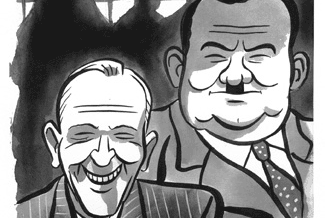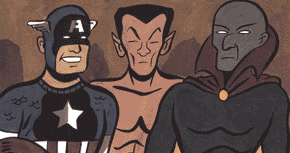|
It
was bound to happen. That is, a small circle of graphic
artists turned comic book creators would make the leap
for the brass ring of posterity by producing museum-quality
work. Among this select few who can get away with it—who
have the chops and the unique vision—the latest entrant
into such gilded company is a skinny, sad-faced cartoonist
from Guelph, Ontario who goes by the single moniker Seth
(real name: Gregory Gallant). With Vernacular Drawing
(Drawn & Quarterly, 2002), he joins the company
of Ben "Julius Knipl" Katchor, Dan "Ghost World" Clowes
and Chris "Jimmy Corrigan" Ware. All of these stellar
artists have chosen this wonderfully retrogressive venue,
the comic book-or, as it's more respectably known, the
graphic novel-and we are all the richer for it. Ware's
Jimmy Corrigan: The Smartest Kid on Earth (Pantheon)
may be the best American novel, in any venue, published
in the last two years.
Seth
shares something with Katchor and Ware, in particular.
These three artists have created a visual universe that
stands in direct opposition to the modern world. In none
of their work will you see a computer (or even the influence
of computer graphics), characters with tattoos or piercings,
political posturing, violence or even vulgar language.
They all seem to be on a religious quest, of sorts, a
pilgrimage to a time when things were, if not better or
happier, then much quieter, much more sane. They seem
to be pining for an irretrievably lost past.
 |
Seth,
prior to Vernacular Drawings—which was published
by Montreal's stellar Drawn & Quarterly, home of other
great comic book artists, like Joe Sacco, Julie "Dirty
Plotte" Doucet, Adrian "Optic Nerve" Tomine, Chester "Yummy
Fur" Brown, and Dylan "Atlas" Horrocks—was best known
for his ongoing series Palookaville. A portion
of that comic book series was published in book form last
year and given one of the great titles of any book in
recent memory: It's a Good Life, If You Don't Weaken
(also published by D & Q).
Even
though Seth is probably known to general audiences—whether
they realize it or not—through his commercial work
for publications like the New York Times, Spin,
Forbes, the New Yorker, the "core" of his
vision is incorruptible. As he explained in a recent bookstore
appearance in New Haven, "There's an upbeat quality to
commercial illustration, and you realize you have subtly
picked it up when you start censoring yourself, doing
what they want rather than what you can get away with.
I am not a gag artist. I don't have a sense of humor."
This
was said with a straight face.
Indeed,
Seth's Vernacular Drawings are beautifully sad,
full-page sketchbook renderings that seem to chronologically
chart the workings of his mind. Each page is stamped with
a date, and the various images, taken from a 12-year period,
unfold pleasantly, almost slipping past as one peruses
the handsome coffee-table-sized volume. Unlike Robert
Crumb—to whom he bears a physical, though slightly
less seedy, resemblance—Seth is not harsh or willfully
repulsive, except in a couple of glaring places that would
have served Vernacular Drawings better to have
been left out. Think of Seth as an existentialist Ludwig
Bemelmans (the Bemelmans of his adult Hotel Splendide
books, not Madeline). All of Seth's figures and
landscapes are formal, from the period when men of all
classes wore fedoras, smoked pipes (Seth's pipes are as
good as Magritte's), sport coats and ties. No jogging
outfits, no SUV's, no strip malls or fast food. Not even
a hint that a television could exist in his world.
To
Seth, according to his note in the front of this book,
"vernacular" means "common in all three senses of the
word—widespread, ordinary and beneath notice." He
goes on: "Just about everything in here was drawn from
sources that are widespread, ordinary and beneath notice;
old magazines, yearbooks, mail-order catalogues, snapshots,
comic books, outdated encyclopedias, girlie magazines,
discarded photo albums, and the many, many other forms
of paper ephemera that endlessly passes through my studio."
The
cumulative effect of the images, though, is powerfully
melancholic, so much so that you begin to worry over the
mental well-being of the artist. As one does when confronted
with a roomful of Joseph Cornell box collages, the viewer
makes an effort to will Seth's vision into existence;
by doing so, perhaps the artist will be rescued. If he
so abjectly pines for the scenes and people he has created,
surely they must exist somewhere. The colors Seth gravitates
toward only reinforce the melancholic glow of his drawings:
olive greens, greys, browns. He has perfected one color
in particular, a light bluish tinge, mixed with brown
and grey that instantly connects with a viewer. The subjects,
too, are telling: isolated train cars in the middle of
nowhere under a huge dark star-filled sky; dilapidated
warehouses, businesses that are closed or bankrupt, silent
groves of trees, empty flyblown streets, emptier than
the most vacated Edward Hopper painting.
 |
The
best of his work—and one can chart the meteoric development
of Seth from beginning to end of this collection—is
of the most recent vintage. And, at least to these eyes—perhaps
because the scenes are unfamiliar—his renderings
of his native Canada stand above the rest. It seems obvious
where Seth should go next: he should do more drawings
from life. His own personal vernacular world in Canada
is as arcane, distant and fascinating as the cityscapes
that Katchor creates from his reimagined New York or Ware
creates from a nostalgia-laced Chicago.
And,
in order to do more drawings from life, Seth might even
have to get out and circulate among people. Who knows,
he might meet someone who will take care of him, put a
few meals in him, give him some small glimmer of hope.
|